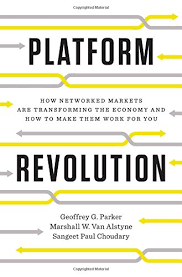Some books are difficult to summarize. Platform Revolution is one such book because its descriptive content requires more. To follow up on my initial overview, I’ll provide a more detailed summary in this commentary and part III of the key platform attributes described by authors Geoffrey Parker, Marshall Van Alstyne and Sangeet Paul Choudary.
Network Effects “refers to the impact that the number of users of a platform has on the value created for each user.” Positive effects occur when a platform produces significant value for each user and are the main source of competitive advantage in a platform business. Network effects are a new economic outcome driven by technology. They are created by demand economies of scale derived from efficiencies in social networks, app development and other phenomena that make a larger network more valuable to users. The largest company in a platform market can create an effect advantage difficult for competitors to overtake. The best such effects are multi-sided. Uber has a two-sided effect by which riders attract drivers, and more drivers attract more riders. Due to the multi-sided effect, platform businesses spend money to attract participants to one side of the market, knowing the other side(s) will follow.
“Designers and builders of any complex system often find it difficult to identify a logical starting point.” Because no two markets are similar, Architecture principles for designing platforms are critical. Regardless of whether an economic exchange occurs in person or virtually, producers and consumers exchange three things: information, goods or services, and currency. The exchange of information occurs first and occurs through the platform itself. Exchange of goods and services, in turn, may occur either on or outside the platform. The same applies to the exchange of currency.
A well-designed platform enables the efficient and scalable exchange of these three things. Platforms are designed one interaction at a time and each interaction comprises three components: the participants, value unit and filter. Many platforms have evolved to multi-sided interactions (LinkedIn) but were first designed for a single interaction by which professionals connected with their peers. Platforms must perform three key functions in order to encourage a high volume of valuable core interactions. They must pull producers and consumers to the platform, facilitate interaction by providing them with tools and rules that make it easy to connect and, lastly, match and connect them by using information. The authors note that platforms can evolve faster when the core is a clean, simple system.
Disruption created through technology innovation is not new, and the authors break it down into two stages. Stage one occurred when efficient pipeline businesses created through technology implementation “ate” inefficient pipeline businesses. Newspapers were disrupted in this stage through the Internet’s ability to distribute news globally. Stage two is defined as when platforms eat pipelines. In this stage, the Internet becomes a creation infrastructure and coordination mechanism as well as a distribution channel, and platforms receive two substantial economic benefits. One is superior marginal economies of production and distribution (Airbnb vs. Marriott). The other is enhanced scalability of operations through network effects, allowing the development of ecosystems potentially embracing millions of global participants.
The early life of a platform is difficult in terms of quality control as new sources of supply are introduced. Over time, network curation kicks in and the matching of suppliers and consumers is improved through better data created from socially-driven feedback loops, enabling the elimination of middlemen or intermediate layers in the distribution process. Leaders of pipeline companies who understand the new business model can build platforms that leverage and strengthen existing assets.
The authors posit that there are eight ways to Launch a successful platform. Creating awareness does not drive adoption and usage by itself. Goods and services must be designed to be so attractive that they pull customers into the platform. Incentives for participation must be organically connected to the interactions facilitated by the platform. Understanding how to begin building a user base for a two-sided market when each side of the market depends on the other is similar to the chicken vs. egg conundrum. The eight strategic approaches to launching a successful platform are:
- Follow the rabbit – Amazon operated a successful online business that functioned as a pipeline. It converted to a platform when it opened its system to external producers.
- Piggyback – Connect with an existing user base from a different platform and stage the creation of value units in order to recruit those users to participate in your platform. PayPal did so when it utilized eBay’s online platform.
- Seeding – Create value units that will be relevant to at least one set of potential users. When these users are attracted to the platform, others who want to engage in interactions with them will follow. Google launched its Android smartphone OS by offering $five million in prizes to app developers for its platform.
- Marquee – Provide incentives to attract members of a key user set onto your platform. PayPal provided cash incentives to entice shoppers to adopt their platform.
- Single-side – Create a business around products or services that benefit a single set of users; later, convert the business into a platform business by attracting a second set of users seeking interactions with the first. OpenTable distributed booking management software for restaurants to manage reservations. After a certain number had adopted the application, it built out the consumer side and collected user fees.
- Producer evangelism – Design your platform to attract producers, who can induce their customers to become users. Education platform Udemy signs up influential teachers, providing them with a revenue share of courses sold.
- Big-Bang adoption – Use one or more traditional push marketing strategies to stimulate interest in, and attention to, your platform. Twitter’s push moment occurred at the 2007 South by Southwest festival.
- Micromarket – Target a tiny market comprising members already interacting. This enables the platform to provide the effective matchmaking characteristic of a large market even in the earlier stages of growth. Facebook’s decision to launch in the small Harvard community allowed it to attract and create an active group of 500 engaged users. It subsequently added campuses as nodes, and took off when it allowed cross-campus friend connections.
Most of us have read about the power of viral growth. The authors state that a viral growth strategy complements any of the above launch strategies. There are four key elements necessary to begin the pull-based process – the sender, the value unit, the external network, and the recipient. Not all of the key attributes for a platform are listed above. In Part III, I will provide a description of the remaining attributes and a wrap-up.











